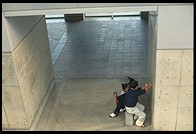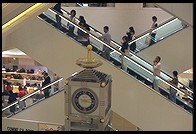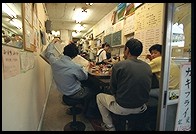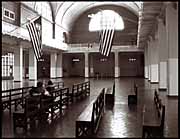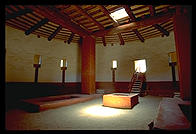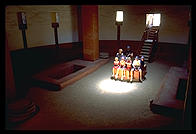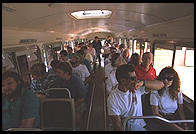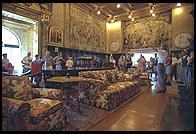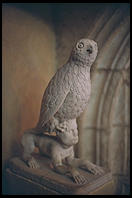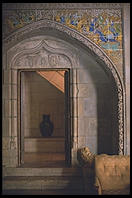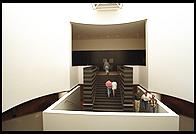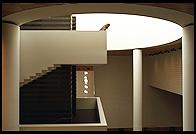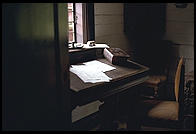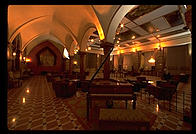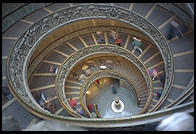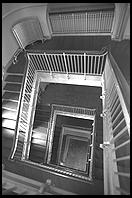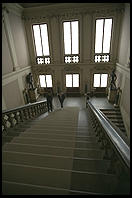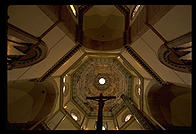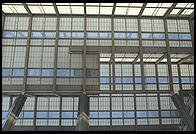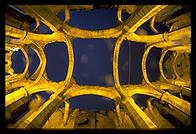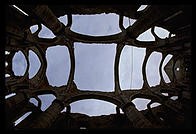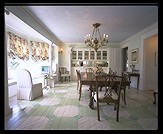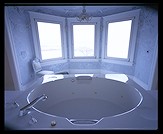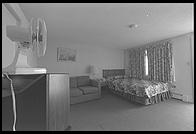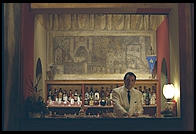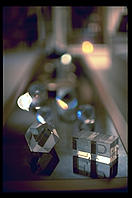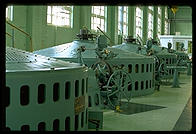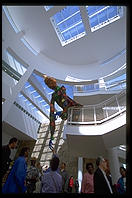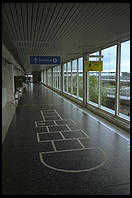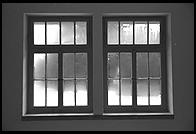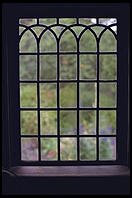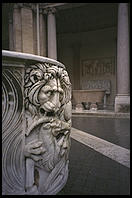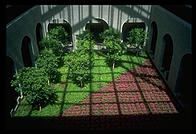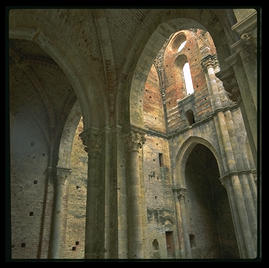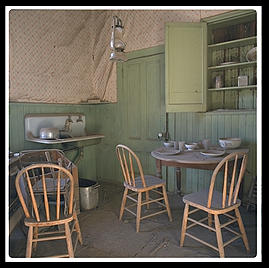This is an example-based tutorial on photographing building interiors.
People and Interiors
The most commercially profitable images of interiors are those devoid of people. Shelter magazines like to enable their readers to project themselves into a pictured dream house. That projection isn't possible if the rooms are already filled up with strangers. Nonetheless, many of the pictures of interiors that are the most successful as photographs are those that show people relating to what the architects have built. Here, for example are a few snapshots from Japan:
The photo below, of the Great Hall at Ellis Island, wouldn't work nearly as well without the two teenagers waiting where so many immigrants waited for so many hours and days (from New York):
People don't always improve an image but they always change it. Below, for example, is the Great Kiva in Aztec Ruins National Monument in Aztec, New Mexico (from my New Mexico guide). The photo at left, without people, conveys more accurately the feeling of being in the kiva. Probably this is because the people aren't using the architecture in the way that the architects intended; they are merely posing for an unseen photographer. The human presence doesn't ruin the image, however. It might be a better choice for a travel guidebook than the empty kiva.
Similarly, as part of a page describing Hearst Castle, these two people-filled images give a better record of the experience of touring the castle than do the detail images underneath:
San Francisco's Museum of Modern Art opened as a beautiful building with hardly any art. Pictures of the stark atrium without people might give a viewer the impression that the museum hadn't opened yet when the photos were taken. With the people, though, the idea of a building filled with human beings fruitlessly searching for art is conveyed (from San Francisco).
Careful with the Light
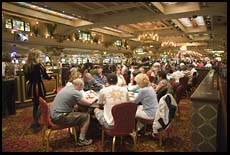
Most camera equipment is designed for handheld use outdoors. As soon as you take them indoors you discover that, on average, it is much darker indoors than outdoors. You won't be able to create a sharp image handholding your camera indoors. Suppose that you stop the lens aperture down to f/11 to ensure adequate depth of field (objects at differing distances from the lens all in reasonably sharp focus). You'll now need to leave the shutter open for a 1/2 second to get enough light to the film to make an image. You won't be able to hold your camera steady for 1/2 second. You have two obvious options: (1) carry a tripod, and (2) illuminate the scene with an electronic flash.
A flash is a lot easier to carry than a tripod. Many cameras have built-in flashes. So why not use the flash for an interior architecture photo? Because you won't capture the architecture.
Rooms and houses are designed around light. Architects who've read A Pattern Language will tell you that you need light from two sides of a room in order to be comfortable in that room. If there is a window on only one wall, the light inside the room will be too contrasty. Architects are very careful with windows and artificial lights.
What about simply sticking the camera on a tripod and using the self-timer or cable release to make a long steady exposure? It can work, as in this photo below, of medieval Skansen village in Stockholm (from Sweden):
We don't mind the contrast and the fact that we can't see detail in a lot of the furniture or the door. The photo gives us an idea of what it is like to use a desk hundreds of years ago in Sweden. A commercial client, however, anxious to sell desks, would demand that a flash or hot light be used to reduce the contrast and render detail in the shadows.
Where a room has a well-designed artificial lighting system, a commercial architectural photographer will often use the existing lights and fixtures to balance the natural light. How is this possible when the sunlight from the windows is so much more powerful than typical incandescent bulbs? The photographer travels with a huge bag of bulbs and will go through a room replacing every bulb with a higher output photoflood. In addition to higher output, tungsten photo bulbs have a consistent color temperature. If a closer match to the color temperature of the window light is desired, the light bulbs through the house may be replaced with electronic flashes. You can buy modestly powerful slave flashes that screw into a light bulb socket from Smith Victor and Morris.
Hollywood goes farther. If it isn't sunny outside and they want warm light from the windows, they park a bank of powerful HMI lights outside the window pointing into the room.
If you're lazy, you can just set the tripod on the floor and accept whatever color temperature comes your way:
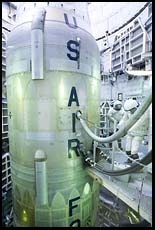
If your assignment does not call for the warm glow of incandescent light, get hold of a Minolta color temperature meter and/or Kodak Professional Photoguide and find the right color correction filter. This becomes much more critical when the room is lit with fluorescent light. Very few people or objects look good with the sickly green cast of daylight-balanced film exposed under fluorescent light. For a film camera, the solution is a Tiffen FL-D filter screwed over the lens. One of the luxuries of photography with digital cameras is that you can simply press the "fluorescent white balance" switch and get very close to the right color balance instantly. Even with a digital camera's ability to set white balance arbitrarily, you still need to think carefully when combining different light sources.
The Drama of the Staircase
You won't have to work hard to get a dramatic staircase image. Stand at the top with a moderately wide-angle lens and point the camera down. The first image below is from the Vatican museum in Rome. It was taken with a Yashica T4 point and shoot camera's fixed 35mm lens, the camera steadied by holding it against the handrail.
Don't Forget to Look Up
Especially in Europe, spend a lot of time looking up towards the ceiling for interesting photos:
The straight "record of what was painted on the ceiling" photo can be made with almost any camera, even where tripods are prohibited. Set the camera to "no flash" and "self-timer" modes. Place the camera on the floor in the middle of the room, lens pointing up. Press the shutter release and back out of the way. Ten seconds later you've got your ceiling.
Go Wide
Fact 1: very few commercial clients are going to thank you for making their rooms look small. Fact 2: very few architects are going to accomodate your desire to knock down a wall so that you can get the entire room into a photo with a normal lens (50mm on a full-frame camera; 30mm on a small sensor digital SLR). Fact 3: Pincushion and barrel distortion, more prevalent with zoom lenses, are much more apparent in architectural work than in general photography. Conclusion: you want some very prime (single focal length, non-zoom) wide angle lenses for architectural interiors.
Sadly, prime wide angle lenses don't exist for small sensor digital
SLRs, such as the cheapest Canon bodies and all of the Nikon DSLRs.
To take in most of a room from a doorway you need a 17mm or wider lens. For example, the first image below is taken with a 43mm lens on Mamiya 7 6x7 format camera. This is equivalent to a 21mm lens on a full-frame digital or 35mm film SLR. Much of the dining room is cut off. The lens was perfect for detail, such as the hot tub overlooking the ocean, but not always wide enough for an entire room at one sweep (from Cape Cod):
By comparison, a 14mm lens on a full-frame or 35mm camera captures an entire motel room from the doorway (also from Cape Cod -- this is the room where Mary Jo Kopechne stayed the night before her death (in Ted Kennedy's car, off the Dike Bridge)):
Go Tight (or at least normal)
Wide, wide, wide all the time makes for dull photography. Sometimes you can highlight details or reveal patterns better with a normal (50mm) or longer lens.
Go Fast (in public)
In public interiors where the use of tripods is prohibited and flash is either prohibited or won't capture the mood that you've found, use a fast lens. A lens with an aperture of f/2.0 will work in light that is 1/4 as bright as that required by a cheap zoom lens's f/4.0 maximum aperture. Going to f/1.4 from f/2.0 allows photography in light that is half as bright. Going from f/1.4 to f/1.0 is another doubling in light-gathering capability. Below is a photo from Elvis's Graceland mansion. Both tripods and flash are prohibited on the tours, making it a natural occasion to drag out the Canon 50/1.0:
Be Industrious
Industrial interiors are some of the most interesting. Don't be shy about asking permission to enter and take some photos. Oftentimes the people who run a factory will be proud to show you around. Here is an old hydro plant interior from my driving tour of Vermont:
Have Fun
Look for humor in and around building interiors. Below are visitors at the Getty Center being entertained by a huge puppet, the whole scene further distorted by the use of a 17mm lens. At right is a hopskotch grid that breaks up a monotonous corridor in the Stockholm aiport (from Sweden):
Outdoors Indoors
Look at the windows per se and the view just beyond the windows...
Also look at interior gardens and courtyards:
Indoors Outdoors
Eventually the indoors will become outdoors and it is always interesting to see nature reclaiming her territory:
Get out the big cameras
Building interiors don't move much. Once you've carefully lit the
scene and lugged a tripod to the right spot in the room, you might as
well try to achieve the best possible image quality. Most
professional architectural photographers use view cameras that offer
control of perspective and the plane of sharp focus. It is convenient to use a
The image below was taken with a Rollei 6008 6x6 SLR (from the Sierra Nevada). Click for an enlargement and examine the detail.
More
- Professional Interior Photography (Michael Harris 1998; Focal Press)
- Interior Shots (Pro-Lighting) (Roger Hicks 1996; Amphoto)
- How to Photograph Buildings and Interiors (Gerry Kopelow 1998; Princeton Architectural Press)
philg@mit.edu
